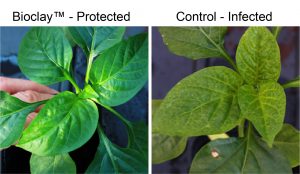Overcoming the ongoing pest and disease threats in horticultural crops
Pest and disease management is a persistent challenge for the horticulture industry, particularly given the additional threats of climate change, pesticide resistance and chemical use limitations. This led researchers at the University of Queensland to investigate novel and sustainable methods of pest and disease control, with the introduction of a clay-based, sustainable crop protection platform. Vegetables Australia provides an update on the BioClay™ project.
The agri-food sector is at an inflection point influenced by climate change, natural disasters, consumer trends, digital disruption, population growth and – most recently – the COVID-19 pandemic.
The coming years will see a significant change in the way we grow, produce, harvest, distribute and consume food and fibre. One of the key constraints in realising food and nutritional security goals are losses caused by pests and diseases. Alternatives to traditional pesticides are needed to help address issues of pesticide resistance, residues and run off to our precious water ways.
Long-term sustainability and profitability of the multi-billion-dollar Australian vegetable and cotton industries depend on game-changing innovations that deliver exceptional value.
One of these innovations is being developed right now. A project is currently being undertaken with the aim to minimise the economic impact of pest infestation on vegetables and cotton crops. This is through the development of BioClayTM, a novel topical protection strategy, which addresses the major challenges of pesticide resistance, lack of natural resistance genes, and public concern surrounding genetically modified (GM) crops.
Researchers at the Queensland Alliance for Agriculture and Food Innovation (QAAFI), a research institute of the University of Queensland, have developed the novel platform as an environmentally sustainable solution to help growers control not only the viruses that infect vegetable crops, but also the insect vectors that transmit the disease.
Led by Professor Neena Mitter and Professor Gordon Xu, the team is working with its commercial partner, Nufarm Limited, to focus on developing this technology. The research is being funded by Hort Innovation and the Cotton Research & Development Corporation.
Gene focus
The BioClay platform is based on harnessing the potential of RNA interference (RNAi), which means interfering with the RNA of the disease-causing agent, rendering it ineffective.
“The RNAi is a conserved gene-silencing mechanism and has been used to engineer disease resistance to pests and pathogens in GM crops,” Professor Mitter explained.
A large body of research exists on using RNAi as a strategy to develop disease resistant plants as a transgenic or GM approach.
“However, the revolutionary BioClay platform circumvents the need for genetic modification by making it possible to use RNAi as a spray or foliar application. The biologically active ingredient, or the ‘Bio’ in BioClay, is the double-stranded RNA (dsRNA) specific to the pest or pathogen being targeted,” Professor Mitter said.
Clay particles act as carriers of the active ingredient and protect it from degrading too quickly when applied on the plant surface.
“When this dsRNA is applied to the plant, the plant recognises it as foreign and chops it up into small bits. When the pest or pathogen comes to infect the plant, its RNA can be rapidly recognised as foreign because it has an identical sequence to the dsRNA that was applied earlier. The plant’s RNAi defence mechanism is triggered, and the pathogen destroyed. It is almost nature versus nature.”
So far, the project team has obtained genome sequences for targeted viral pathogens. These have been used to design dsRNA constructs targeting vegetable crop viruses, including cotton leaf curl virus. Genomic information has also been recorded for white flies, a cotton and vegetable pest that is also a virus vector.
“These have been tested in laboratory and glasshouse experiments on crop hosts such as capsicum, zucchini and cotton. The stability of the BioClay-loaded dsRNA has been tested on shelf, in glasshouse and field conditions with promising results,” Professor Mitter said.
“Work is progressing on scaling up the trials and any modifications as desired to improve the adoption of the technology. Industry partner Nufarm is concurrently looking at large-scale dsRNA production, BioClay synthesis and regulatory considerations.”

Industry benefits
Professor Mitter said this research will produce a stronger alignment between consumer wants (clean, green food) and industry needs (alternative chemical-free disease control measures). The product will deliver an Australian-owned and invented non-GM, target-specific, easy-to-adopt, and environment-, farmer- and consumer-friendly crop protection solution.
“The current project is progressed to field trials, with further validation and commercial formulation development needed, as well as studies that involve dose range, formulation, spray schedules, suitability in different climate conditions and the data required to address the regulatory framework,” she said.
“This project will also set the scene for translating this technology to other pests and pathogens that pose a serious biosecurity threat to Australia.”
The team is working with its research collaborators and Nufarm to create a commercially valuable system for growers. This platform will allow sustainable crop health management solutions for the Australian horticultural market, and enhanced environmental credentials of Australian crops.
Find out more
Please contact Professor Neena Mitter at n.mitter@uq.edu.au. More information can be found here.
Novel topical vegetable, cotton virus and whitefly protection (VG16037) is a strategic levy investment under the Hort Innovation Vegetable Fund.
This project has been funded by Hort Innovation using the vegetable research and development levy and contributions from the Australian Government.
Project Number: VG16037
Cover image: Professor Neena Mitter accompanied by Dr Karl Robinson and Dr Elizabeth Worrall, members of the BioClay team. Image courtesy of QAAFI.

